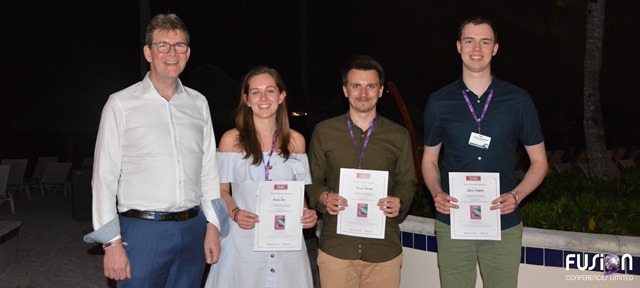3rd Niche-epithelial Stem Cell Interactions in Lung Health and Disease Conference

Conference Report: 3rd Small Molecule Activation Conference
The third Fusion conference on Small Molecule Activation took place from 19th – 22nd February 2019 in Nassau, the Bahamas. The meeting was chaired by Christian Limberg (Humboldt-Universität zu Berlin, Germany).
The first day was dedicated to the conversion of hydrocarbons and carbon dioxide. Mu-Hyun Baik (KAIST, plenary) introduced new approaches utilizing electro-inductive effects, Matthias Tamm (Technische Universität Braunschweig) talked about alkyne metathesis, Alan Goldberg (Rutgers University) about C-H bond activation and Ian Tonks (University of Minnesota) about the activation of isocyanides. Osamu Ishitani (Tokyo Institute of Technology) then reported about latest developments with regard to photocatalytic CO2 reduction, while Hideki Masuda (Nagoya Institute of Technology) focused on electrochemical approaches in ionic liquids. Yunho Lee (KAIST) presented biomimetic model studies concerning CO2 conversion.
The morning of day 2 was dedicated to dioxygen activation, with various contributions from the area of bioinorganic chemistry. Daniel Stack (Stanford University), Sonja Herres-Pawlis (RWTH Aachen University) and Jalila Simaan (Aix-Marseille Université) reported about their attempts to understand and mimic copper enzymes, while Elodie Anxolabéhère-Mallart (Université Paris Diderot) and Carole Duboc (Univ. Grenoble Alpes) focused on bioinspired iron and manganese complexes and their mechanistic investigation. M. Teresa Corona Prieto (Humboldt-Universität zu Berlin) reported findings on the generation of an iron(II) hydroperoxide complex, and Lars Müller (Humboldt-Universität zu Berlin) about low-molecular weight analogues of non-heme iron oxygenases. Martin Albrecht (Universität Bern) complemented the previous session on CO2 discussing its electrochemical conversion utilizing mesoionic ligands.
After a period of leisure time in a beautiful environment the scientific part of the day continued by lectures about N2O and NO activation starting with a plenary talk by Karsten Meyer (Friedrich Alexander University Erlangen-Nürnberg) on the redox-behavior and electronic structures of iron-NO complexes. Timothy H. Warren
(Georgetown University) discussed the conversion of NO in the coordination sphere of copper centers and Neal Mankad (University of Illinois at Chicago) bioinspired N2O activation at polynuclear copper entities. Trevor Hayton (UC Santa Barbara) finished the day illustrating the reaction of N2O with nickel sulfide moieties.
The next morning started with the binding and activation of dinitrogen. Sven Schneider (Georg-August-Universität Göttingen) presented the results of electrochemical investigations, Oliver Einsle (University of Freiburg) revealed the tricks enzymes use for this purpose and Andrew Ashley (Imperial College London) talked about progress trying to replicate those with molecules.
Thereafter dihydrogen formed the topic of three talks. A plenary lecture given by Morris Bullock (Pacific Northwest National Laboratory) presented new ways of cleaving dihydrogen at strongly reduced iron compounds, Jan Paradies (Universität Paderborn) highlighted the advantages of using frustrated Lewis-pairs and Michael Shevlin (Merck) outlined an industrial high-throuput approach to catalyst discovery.
The last session dealt with the utilization of cooperativity in small molecule activation. Connie Lu (University of Minnesota) and Eva Hevia (University of Strathclyde) discussed the influence of a second metal in direct or close proximity and Nathaniel Szymczak (University of Michigan) the effects of a Lewis acid.
There followed the poster session and a very enjoyable Gala dinner including the awarding of the poster prizes.
The last day started with a plenary lecture by David Milstein (Weizmann Institute of Science) on catalytic design based on metal-ligand cooperation followed by a presentation by Karl Kirchner (TU Wien) on the potential of iron hydride pincer complexes. Pincer complexes of earth abundant metals and their catalytic behavior also formed the topic of a lecture given by Lutz Gade (Universität Heidelberg). Finally Christian Limberg (Humboldt-Universität zu Berlin) presented models for intermediates formed by CO2-activating enzymes and the program was concluded by a plenary lecture given by William Evans (University of California, Irvine) illustrating the capabilities of reduced lanthanide complexes in the area of small molecule activation.
Hence, the conference gathered excellent scientists from all over the world covering a wide range of small molecule activation. It thus revealed common principles, prerequisites for catalysis and current trends/frontiers.
The conference venue allowed for a very relaxed atmosphere for discussion, networking, and setting up collaborations. Due to the high quality of the speakers and their lectures, they received the unshared attention of all participants – despite the temptations waiting outside the lecture halls.
The representatives of Fusion on site were most professional, helpful and reliable and at the same time pleasant to be with; all participants were very impressed with the high organization level of the meeting. There was general agreement among the participants that a fourth meeting should be organized for 2021 on the same topic, as progress is rapid in this field, which forms the basis of an efficient exploitation of our resources.
The meeting was sponsored by the GS Glovebox Systemtechnik, as well as by the journals Inorganic Chemistry, Organometallics, Accounts of Chemical Reseach (all American Chemical Society) and ZAAC (Wiley-VCH).

Poster award winners Leonie Bole (University of Strathclyde), Tomasz Pietrzak (Warsaw University of Technology), Joshua Sapsford (Imperial College London)
